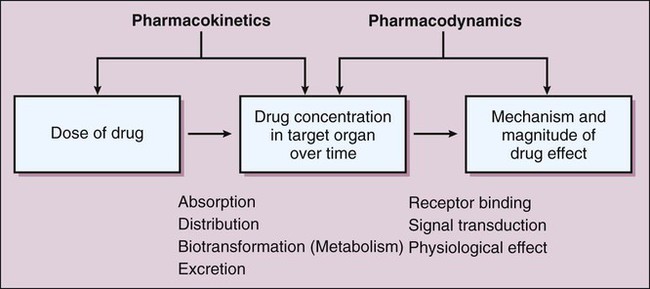The history of many significant events in pharmacology, as highlighted by selected Nobel Prize recipients, is presented in Table 1-1. TABLE 1-1 The Nobel Prize and the History of Pharmacology* *Selected from the list of recipients of the Nobel Prize for Physiology or Medicine; note that many other discoveries pertinent to pharmacology have been made by other Nobel Prize winners in this field and in the field of chemistry and that the original discovery was often made many years before the Nobel Prize was awarded. Pharmacology is divided into two main subdivisions, pharmacokinetics and pharmacodynamics. The relationship between these subdivisions is shown in Figure 1-1. Pharmacokinetics is concerned with the processes that determine the concentration of drugs in body fluids and tissues over time, including drug absorption, distribution, biotransformation (metabolism), and excretion. Pharmacodynamics is the study of the actions of drugs on target organs. A shorthand way of thinking about it is that pharmacodynamics is what the drug does to the body, and pharmacokinetics is what the body does to the drug. Modern pharmacology is focused on the biochemical and molecular mechanisms by which drugs produce their physiologic effects and with the dose-response relationship, defined as the relationship between the concentration of a drug in a tissue and the magnitude of the tissue’s response to that drug. Most drugs produce their effects by binding to protein receptors in target tissues, a process that activates a cascade of events known as signal transduction. Pharmacokinetics and pharmacodynamics are discussed in greater detail in Chapters 2 and 3. Pharmacotherapeutics is the medical science concerned with the use of drugs in the treatment of disease. Pharmacology provides a rational basis for pharmacotherapeutics by explaining the mechanisms and effects of drugs on the body and the relationship between dose and drug response. Human studies known as clinical trials are then used to determine the efficacy and safety of drug therapy in human subjects. The purpose, design, and evaluation of human drug studies are discussed in Chapter 4.
Introduction to Pharmacology
Pharmacology and Related Sciences
History and Role of Pharmacology
PERSON(S) AND YEAR AWARDED
SIGNIFICANT DISCOVERY IN PHARMACOLOGY
Ilya Metchnikoff, Paul Ehrlich (1908)
First antimicrobial drugs (magic bullet)
Frederick Banting, John Macleod (1923)
Isolation and discovery of insulin and its application in the treatment of diabetes
Sir Henry Dale, Otto Loewi (1936)
Chemical transmission of nerve impulses
Sir Alexander Fleming, Ernst Chain, Sir Howard Florey (1945)
Discovery of penicillin and its curative effect in various infectious diseases
Edward Kendall, Tadeus Reichstein, Philip Hench (1950)
Hormones of the adrenal cortex, their structure and biologic effects
Daniel Bovet (1957)
Antagonists that block biologically active amines, including the first antihistamine
Sir Bernard Katz, Ulf von Euler, Julius Axelrod (1970)
Transmitters in the nerve terminals and the mechanism for storage, release, and inactivation
Earl Sutherland, Jr. (1971)
Mechanisms of the action of hormones with regard to inhibition and stimulation of cyclic AMP
Sune Bergström, Bengt Samuelsson, John Vane (1982)
Discovery of prostaglandins and the mechanism of action of aspirin that inhibits prostaglandin synthesis
Sir James Black, Gertrude Elion, George Hitchings (1988)
Development of the first β-blocker, propranolol, and anticancer agents that block nucleic acid synthesis
Alfred Gilman, Martin Rodbell (1994)
Discovery of G proteins and the role of these proteins in signal transduction in cells
Robert Furchgott, Louis Ignarro, Ferid Murad (1998)
Recognition of nitric oxide as a signaling molecule in the cardiovascular system
Arvid Carlsson, Paul Greengard, Eric Kandel (2000)
Role of dopamine in schizophrenia and signal transduction in the nervous system leading to long-term potentiation
Pharmacology and Its Subdivisions
Pharmacotherapeutics
Drug Sources and Preparations
< div class='tao-gold-member'>
![]()
Stay updated, free articles. Join our Telegram channel

Full access? Get Clinical Tree



